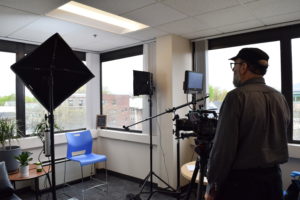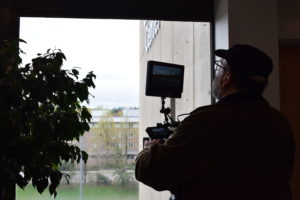Mastering Corporate Video Production: Turning Challenges into Opportunities
As videographers, we are no strangers to unexpected hurdles.
Even the most meticulously planned shoots can be thrown off course by lighting quirks, unwanted reflections, or the symphony of urban sounds.
But our expertise lies in transforming these obstacles into opportunities, crafting compelling videos that transcend the challenges we face.
In this article, we explore the art of adapting to conquer common challenges in corporate video production, showcasing how flexibility and creativity can elevate your video projects to new heights.
Table of Contents
A Corporate Interview with a View: Lighting the Way
Our recent corporate interview shoot, subcontracted by FreshTV Videomarketing, tested our adaptability.
The chosen conference room boasted a picturesque window directly behind our talent, but it posed a lighting dilemma.
The bright sunlight threatened to wash out the background or leave our subject in shadow.
Enter Chuck Green, our skilled videographer, armed with 200W of LED lighting.
By strategically positioning two fixtures, he expertly balanced the luma levels, ensuring our talent was clearly visible without being overwhelmed by the sunlight. The cloudy New England sky also played its part, allowing for further adjustments in post-production.
We didn’t stop there. We tweaked the camera and talent positions to incorporate a charming church steeple into the frame and strategically draped black fabric over distracting objects.
By minimizing reflections and adjusting office lights, we created a polished and professional backdrop.
Rolling with the Punches: Camera Movement and Carpet Conundrums
Capturing the interview in 4K with multiple takes guarantees optimal answers and intonation. However, our dolly shots faced a unique challenge: the heavily textured carpet.
Undeterred, we adapted our approach, moving the dolly only along the carpet’s ridges for smooth, seamless movement.
For B-roll, we ventured both inside and outside the office, capturing a mix of staged and natural shots.
While the textured carpet limited our indoor camera movements, we embraced the constraint, focusing on creative framing and composition to tell a compelling visual story.
Sound Solutions: Silencing the City
Our biggest hurdle was the persistent street noise filtering through the window.
To mitigate this, we positioned the camera lower than usual, in front of our talent, creating a natural sound barrier.
As always, we recorded 20 seconds of room tone for seamless integration of additional footage.
The Videographer’s Secret Weapon: Adaptability
In the world of video production, challenges are inevitable.
But an experienced videographer doesn’t just anticipate obstacles; they embrace them.
By adapting on the fly and finding creative solutions, we ensure that your video shines, despite any unexpected twists and turns along the way.
Frequently Asked Questions
How can videographers handle challenging lighting conditions during corporate shoots?
Videographers can manage challenging lighting conditions by strategically using artificial lighting to balance natural light sources.
For instance, during a recent corporate interview, we faced the issue of bright sunlight streaming through a window behind our subject.
By employing 200W LED lights and adjusting their placement, we balanced the light levels to ensure the subject was well-lit without being overshadowed by the sunlight.
Additionally, utilizing elements like black fabric to minimize reflections and making adjustments in post-production can further refine the visual quality.
What strategies can be used to achieve smooth camera movement on difficult surfaces like textured carpets?
Achieving smooth camera movement on textured surfaces, such as heavily textured carpets, can be challenging.
One effective strategy is to move the dolly along the ridges of the carpet, rather than across the textured surface. This approach was used in a recent shoot to ensure seamless dolly shots despite the carpet’s limitations.
Focusing on creative framing and composition can also help compensate for restricted movement, allowing videographers to tell a compelling visual story.
How can sound issues, such as street noise, be mitigated during a video shoot?
Sound issues, like persistent street noise, can be mitigated by using creative positioning and sound barriers.
During a recent shoot, we positioned the camera lower than usual, in front of our talent, to act as a natural sound barrier against street noise filtering through the window.
Additionally, recording 20 seconds of room tone helps integrate additional footage seamlessly, ensuring consistent audio quality.
Employing high-quality microphones and soundproofing materials can further enhance sound capture and reduce unwanted noise.
What role does adaptability play in successful video production?
Adaptability is crucial in video production as it allows videographers to handle unexpected challenges effectively.
An experienced videographer not only anticipates potential obstacles but also embraces them as opportunities for creative problem-solving. Whether dealing with lighting issues, sound disturbances, or movement constraints, being flexible and resourceful ensures that the final product remains polished and professional.
Adaptability transforms challenges into opportunities to enhance the visual storytelling experience.
How can creative solutions improve the quality of corporate video production?
Creative solutions significantly enhance the quality of corporate video production by addressing and overcoming obstacles that might otherwise compromise the final product.
For example, adjusting lighting setups, creatively framing shots, and employing sound barriers are all methods that can turn potential issues into strengths.
By focusing on innovative approaches and continuously refining techniques, videographers can produce high-quality, engaging videos that meet client expectations and resonate with the target audience.
Share:
Search our blog:
Follow us on:



